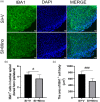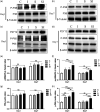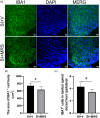Dehydrocorydaline alleviates sleep deprivation-induced persistent postoperative pain in adolescent mice through inhibiting microglial P2Y12 receptor expression in the spinal cord
- PMID: 37940138
- PMCID: PMC10748710
- DOI: 10.1177/17448069231216234
Dehydrocorydaline alleviates sleep deprivation-induced persistent postoperative pain in adolescent mice through inhibiting microglial P2Y12 receptor expression in the spinal cord
Abstract
During adolescence, a second period of central nervous system (CNS) plasticity that follows the fetal period, which involves sleep deprivation (SD), becomes apparent. SD during adolescence may result in abnormal development of neural circuits, causing imbalance in neuronal excitation and inhibition, which not only results in pain, but increases the chances of developing emotion disorders in adulthood, such as anxiety and depression. The quantity of surgeries during adolescence is also consistently on the rise, yet the impact and underlying mechanism of preoperative SD on postoperative pain remain unexplored. This study demonstrates that preoperative SD induces upregulation of the P2Y12 receptor, which is exclusively expressed on spinal microglia, and phosphorylation of its downstream signaling pathway p38Mitogen-activated protein/Nuclear transcription factor-κB (p38MAPK/NF-κB)in spinal microglia, thereby promoting microglia activation and microglial transformation into the proinflammatory M1 phenotype, resulting in increased expression of proinflammatory cytokines that exacerbate persisting postoperative incisional pain in adolescent mice. Both intrathecal minocycline (a microglia activation inhibitor) and MRS2395 (a P2Y12 receptor blocker) effectively suppressed microglial activation and proinflammatory cytokine expression. Interestingly, supplementation with dehydrocorydaline (DHC), an extract of Rhizoma Corydalis, inhibited the P2Y12/p38MAPK/NF-κB signaling pathway, microglia activation, and expression of pro-inflammatory cytokines in the model mice. Taken together, the results indicate that the P2Y12 receptor and microglial activation are important factors in persistent postoperative pain caused by preoperative SD in adolescent mice and that DHC has analgesic effects by acting on these targets.
Keywords: P2Y12 receptor; dehydrocorydaline; incisional pain; inflammation; microglia; sleep deprivation.
Conflict of interest statement
Declaration of conflicting interestsThe author(s) declared no potential conflicts of interest with respect to the research, authorship, and/or publication of this article.
Figures















Similar articles
-
Pretreatment of the ROS Inhibitor Phenyl-N-tert-butylnitrone Alleviates Sleep Deprivation-Induced Hyperalgesia by Suppressing Microglia Activation and NLRP3 Inflammasome Activity in the Spinal Dorsal Cord.Neurochem Res. 2023 Jan;48(1):305-314. doi: 10.1007/s11064-022-03751-5. Epub 2022 Sep 14. Neurochem Res. 2023. PMID: 36104611 Free PMC article.
-
HIV1 gp120 activates microglia via TLR2-nf-κb signaling to up-regulate inflammatory cytokine expression and induce neuropathic pain.Neuropharmacology. 2024 Dec 1;260:110136. doi: 10.1016/j.neuropharm.2024.110136. Epub 2024 Aug 30. Neuropharmacology. 2024. PMID: 39216684
-
Activation of dorsal horn cannabinoid CB2 receptor suppresses the expression of P2Y12 and P2Y13 receptors in neuropathic pain rats.J Neuroinflammation. 2017 Sep 12;14(1):185. doi: 10.1186/s12974-017-0960-0. J Neuroinflammation. 2017. PMID: 28899427 Free PMC article.
-
Microglia: a promising target for treating neuropathic and postoperative pain, and morphine tolerance.J Formos Med Assoc. 2011 Aug;110(8):487-94. doi: 10.1016/S0929-6646(11)60074-0. J Formos Med Assoc. 2011. PMID: 21783017 Free PMC article. Review.
-
Microglia and spinal cord synaptic plasticity in persistent pain.Neural Plast. 2013;2013:753656. doi: 10.1155/2013/753656. Epub 2013 Aug 18. Neural Plast. 2013. PMID: 24024042 Free PMC article. Review.
References
-
- Cao P, Chen C, Liu A, Shan Q, Zhu X, Jia C, Peng X, Zhang M, Farzinpour Z, Zhou W, Wang H, Zhou JN, Song X, Wang L, Tao W, Zheng C, Zhang Y, Ding YQ, Jin Y, Xu L, Zhang Z. Early-life inflammation promotes depressive symptoms in adolescence via microglial engulfment of dendritic spines. Neuron 2021; 109: 2573–2589.e2579. DOI: 10.1016/j.neuron.2021.06.012. - DOI - PubMed
-
- Urrila AS, Artiges E, Massicotte J, Miranda R, Vulser H, Bézivin-Frere P, Lapidaire W, Lemaître H, Penttilä J, Conrod PJ, Garavan H, Paillère Martinot ML, Martinot JL. Sleep habits, academic performance, and the adolescent brain structure. Scientific reports 2017; 7: 41678. DOI: 10.1038/srep41678. - DOI - PMC - PubMed
MeSH terms
Substances
LinkOut - more resources
Full Text Sources

